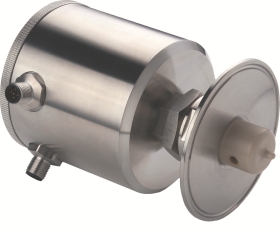

The CIP system consists of four tanks for fresh water, cleaning agents, returns and wastewater, plus the parallel cleaning system for up to three trucks. The independent process lines are designed for fast, hygienic operation that is optimised in terms of ecological and economic aspects. From the tanks installed in the basement, cleaning media is pumped upwards into the milk or food trucks and flows back from there through hydrostatic pressure. In contrast to the otherwise frequently practiced ‘lost process ‘, the circulation and multiple recycling of the cleaning agents was a crucial requirement due to environmental protection and cost aspects. The advantages provided by such a system include:
• Complete process sensor technology for reliable and sustainable CIP cleaning from a single source.
• Inline measurement of critical parameters enables precise process control and thus a verifiable quality for the certification of the cleaning.
• High measuring accuracy and short reaction times ensure resource efficiency (e.g. saving of cleaning agents, reduction of wastewater volume) a crucial requirement here due to environmental protection and cost aspects.
CIP cleaning takes place in three stages
1. Pre-rinsing with water from the return tank.
2. CIP cleaning with 1-phase cleaner, then depending on concentration either recirculation into cleaning agent tank or discharge into return tank.
3. Flushing with fresh water with discharge into the return tank.
For reliable and certifiable cleaning and maximum utilisation of the cleaning agents, temperature, conductivity and flow rate must correspond exactly to the specifications. These values are controlled permanently and with the utmost precision inline.
For all applications in the process, Anderson-Negele sensors were able to offer an appropriate solution, thus ensuring optimum function, efficiency and process reliability for the end user.
Principle of operation
Different measuring methods ensure process reliability for the tanks. Capacitive level detectors NCS-M-11, installed at the top and bottom, transmit the full or empty signal to the PLC with the shortest reaction time in order to reliably prevent overflow during filling or pump idling. Type L3 pressure sensors are used for permanent volume measurement and to monitor the exact filling level. The temperature is continuously measured by dead-leg optimised TFP-161 sensors.
For correct cleaning, the media must always be pumped into the truck and their integrated spray heads with a specified, optimum pressure. Installed right after the pump, electromagnetic flowmeters and pressure transmitters accurately monitor this process step. After the cleaning process, the media are analysed inline and their return to the corresponding tanks is monitored by calorimetric flow switches.
The analysis of the return media is one of the most important steps for an environmentally friendly and cost-efficient process. The ILM-4 inductive conductivity meter plays a central role in precisely determining the phase separation: during the discharge of the liquids at each cleaning stage the media are differentiated with cost-saving accuracy. Reusable cleaning agent that flows off after cleaning can thus be returned to the tank to the maximum possible degree. In a separate, internal circulation and for permanent optimum cleaning result, its concentration is adapted to the specified ideal value by re-dosing with detergent and fresh water in the cleaning agent tank. The ILM-4 conductivity meter also ensures the highly precise measurement of conductivity and temperature required here.
| Email: | [email protected] |
| www: | www.mortoncontrols.co.za |
| Articles: | More information and articles about Morton Controls |
© Technews Publishing (Pty) Ltd | All Rights Reserved